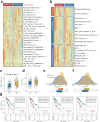Integrative multi-omics and machine learning reveal critical functions of proliferating cells in prognosis and personalized treatment of lung adenocarcinoma
- PMID: 40681687
- PMCID: PMC12274462
- DOI: 10.1038/s41698-025-01027-z
Integrative multi-omics and machine learning reveal critical functions of proliferating cells in prognosis and personalized treatment of lung adenocarcinoma
Abstract
Lung adenocarcinoma (LUAD) is a major cause of cancer-related mortality globally. Proliferating cells, crucial components of the tumor immune microenvironment (TIME), play a significant role in cancer progression and immunotherapy response. Herein, we utilized multi-omics data and employed a multifaceted approach to delineate the proliferating cell landscape in LUAD. The Scissor algorithm was applied to identify Scissor+ proliferating cell genes associated with prognosis. An integrative machine learning program, comprising 111 algorithms, was developed to construct a Scissor+ proliferating cell risk score (SPRS). The SPRS model demonstrated superior performance in predicting prognosis and clinical outcomes compared to 30 previously published models. The role of SPRS and five pivotal genes in immunotherapy response was evaluated, and their expression was experimentally verified. Multifactorial analysis confirmed SPRS as an independent prognostic factor affecting LUAD patient survival. High- and low-SPRS groups exhibited different biological functions and immune cell infiltration in the TIME. High SPRS patients showed resistance to immunotherapy but increased sensitivity to chemotherapeutic and targeted therapeutic agents. Our study elucidates the dynamics of proliferating cells in LUAD, enhancing prognostic accuracy and highlighting the potential of SPRS and its constituent genes for personalized therapeutic interventions.
© 2025. The Author(s).
Conflict of interest statement
Competing interests: The authors declare no competing interests. Ethical statement: This study was reviewed and approved by the Ethics Committee of Shanghai Xuhui Central Hospital (Approval No.: 2022-021). Written informed consent was obtained from all participants prior to enrollment. All procedures strictly adhered to the principles of the Declaration of Helsinki and relevant national/international ethical guidelines.
Figures











References
-
- Siegel, R. L., Miller, K. D., Wagle, N. S. & Jemal, A. Cancer statistics, 2023. Ca Cancer J. Clin.73, 17–48 (2023). - PubMed
-
- Herbst, R. S., Morgensztern, D. & Boshoff, C. The biology and management of non-small cell lung cancer. Nature553, 446–454 (2018). - PubMed
-
- Shiraishi, Y., Sekino, Y., Horinouchi, H., Ohe, Y. & Okamoto, I. High incidence of cytokine release syndrome in patients with advanced NSCLC treated with nivolumab plus ipilimumab. Ann. Oncol.34, 1064–1065 (2023). - PubMed
LinkOut - more resources
Full Text Sources

